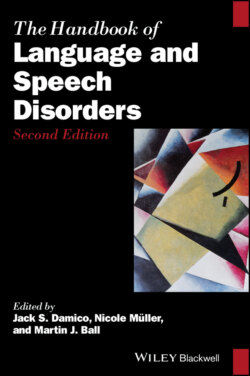Читать книгу The Handbook of Language and Speech Disorders - Группа авторов - Страница 2
Table of Contents
Оглавление1 Cover
2 Title Page
3 Copyright Page
4 List of Figures
5 Notes on Contributors
6 Introduction
7 Part I: Foundations 1 Labeling as a Sociocultural Process in Communicative Disorders 1.1 Introduction 1.2 Labeling Theory 1.3 Labeling within a Diagnostic Process 1.4 The Impact of Labeling 1.5 Concerns with the Process of Diagnostic Labeling 1.6 Implications and Conclusion REFERENCES 2 Diversity Considerations in Speech and Language Disorders 2.1 Introduction 2.2 Some Facts 2.3 What is There and What is Missing 2.4 Identifying an MMI Curriculum 2.5 Relevant Theory 2.6 Relevant Applications 2.7 Issues in Cultural Competence 2.8 Concluding Statements REFERENCES 3 Hearing Loss and Cochlear Implants 3.1 Introduction 3.2 Hearing Loss 3.3 Cochlear Implants 3.4 Auditory Brainstem Implants 3.5 Conclusions and Perspectives Acknowledgments REFERENCES 4 Intelligibility Impairment 4.1 Introduction 4.2 Intelligibility Defined 4.3 Measurement of Intelligibility 4.4 Intelligibility from a Developmental Perspective 4.5 Perceptual Learning 4.6 Individual Differences 4.7 Summary REFERENCES 5 Genetic Syndromes and Communication Disorders 5.1 Why Study Genetic Syndromes? 5.2 Language and Communication in Williams Syndrome (WS) 5.3 Language and Communication in Down Syndrome (DS) 5.4 Conclusions REFERENCES 6 Principles of Assessment and Intervention 6.1 Introduction 6.2 Principles of Assessment and Intervention 6.3 Principles in Practice REFERENCES
8 Part II: Language Disorders 7 Autism Spectrum Disorders 7.1 Introduction 7.2 Diagnostic Criteria 7.3 Early Markers of Autism Spectrum Disorder 7.4 Gold Standards for Comprehensive Assessment of Autism 7.5 Principles for Intervention Decision‐making 7.6 Established Evidence‐Based Interventions 7.7 Summary References 8 Language Acquisition and Language Delay 8.1 Introduction 8.2 Individual Differences 8.3 From Individual Differences to Individual Profiles 8.4 Tracking Grammatical Development in Detail 8.5 Envoi Acknowledgment REFERENCES 9 Developmental Language Disorder 9.1 Introduction 9.2 Defining and Identifying Children with Language Disorders 9.3 Subtyping and Classification of Children with DLD 9.4 Implications of Subtyping Research for Clinical Practice 9.5 General Outcomes and Long‐term Stability for DLD 9.6 Causal Explanations for DLD 9.7 Intervention Outcomes 9.8 Summary and Conclusions Acknowledgment REFERENCES 10 Pragmatic Impairment 10.1 Introduction 10.2 Mental State Attribution During Communication 10.3 Scope of Pragmatic Impairment 10.4 Language in Pragmatic Impairment 10.5 Pragmatic Language Assessment and Intervention 10.6 Summary REFERENCES 11 Learning Disabilities 11.1 Introduction 11.2 Historical Context and Definition 11.3 Types of Learning Disabilities 11.4 “Specific” Disabilities in Language and Reading 11.5 Theories of Learning Disabilities 11.6 Etiology of Learning Disabilities 11.7 Identification and Intervention 11.8 Impact of LD in Adulthood 11.9 Summary REFERENCES 12 Literacy and Literacy Impairments 12.1 Introduction 12.2 Conceptualizations of Literacy 12.3 Literacy as Social Practice 12.4 Literacy as Personal Skill 12.5 Solutions and Conclusions REFERENCES 13 Language and Literacy in the Context of Early Life Adversity 13.1 Introduction 13.2 A Strong Start to Life Promotes Prosocial Interpersonal Skills in the Preschool Years 13.3 Developmental Language Disorder 13.4 Language and Culture 13.5 Threats to Optimal Child and Adolescent Language Development 13.6 Language Disorder: Diagnosis and Assessment in Vulnerable Populations 13.7 Assessment Processes and Considerations 13.8 Summary and Conclusions REFERENCES 14 Aphasia 14.1 What is Aphasia? 14.2 The Incidence and Prevalence of Aphasia 14.3 Some History 14.4 The Features of Aphasia 14.5 Recovery and Treatment 14.6 Psychosocial and Emotional Response to Aphasia REFERENCES
9 Part III: Speech Disorders 15 Children with Speech Sound Disorders 15.1 Introduction 15.2 Normal Speech Development 15.3 Nature of Speech Sound Disorders 15.4 Clinical Management of Speech Sound Disorders 15.5 Conclusion REFERENCES 16 Dysarthria 16.1 The Brain Network of Speech Motor Control in Typical Adult Speakers 16.2 Dysarthria: Classification and Taxonomy 16.3 Dysarthric Deficits in Neurological Disorders 16.4 Auditory‐Perceptual and Instrumental Analysis of Motor Speech Disorders 16.5 Therapeutic Approaches in Dysarthria REFERENCES 17 Apraxia of Speech 17.1 Introduction 17.2 Etiologies of AOS 17.3 Features and Differential Diagnosis 17.4 Assessment 17.5 Treatment 17.6 Summary REFERENCES 18 Augmentative and Alternative Communication 18.1 Introduction 18.2 AAC Systems 18.3 Components of Aided AAC Systems 18.4 Assessment 18.5 AAC Intervention 18.6 Summary REFERENCES 19 Fluency and Fluency Disorders 19.1 Introduction 19.2 Stuttering Evaluation and Assessment 19.3 Epidemiological Issues Related to Stuttering Based on Longitudinal Studies 19.4 Causes of Stuttering 19.5 Treatment Techniques and Efficacy 19.6 Developmental Trends in Stuttering and Stuttering Theory: Yesterday and Today 19.7 Summary REFERENCES 20 Describing, Assessing, and Treating Voice Disorders 20.1 Introduction 20.2 Prevalence of Voice Disorders 20.3 Recent Developments in Voice and Voice Disorders 20.4 Voice Evaluations 20.5 Voice Therapy REFERENCES 21 Speech Disorders Related to Cleft Palate and Velopharyngeal Dysfunction 21.1 Introduction 21.2 Cleft Lip and Palate and Non‐cleft Velopharyngeal Dysfunction 21.3 Speech Development in Children Born with Cleft Palate 21.4 Intervention 21.5 Types of Intervention 21.6 Language Development in Children Born with Cleft Palate 21.7 Impact on Academic Achievement 21.8 The ICF‐CY, HRQoL and PROMs 21.9 Clinical Audit and Research 21.10 Conclusion REFERENCES 22 Speech Disorders Related to Head and Neck Cancer 22.1 Introduction 22.2 Total Laryngectomy 22.3 Partial Laryngectomies 22.4 Glossectomy 22.5 Velopharyngeal Defects 22.6 Maxillofacial and Facial Defects Acknowledgment REFERENCES
10 Part IV: Cognitive and Intellectual Disorders 23 ADHD and Communication Disorders 23.1 Introduction 23.2 What is ADHD? 23.3 The Nature of ADHD 23.4 ADHD and Language Learning Disabilities 23.5 Implications for Assessment and Intervention 23.6 Conclusion REFERENCES 24 Communication Deficits Associated with Right Hemisphere Brain Damage 24.1 Introduction 24.2 Overview of Disorders of Communication 24.3 Themes Underlying Comprehension Disorders 24.4 Discourse Production Deficits 24.5 Assessment 24.6 Conclusions REFERENCES 25 Traumatic Brain Injury 25.1 Introduction 25.2 Overview 25.3 Cognitive‐Communication Disorders Following TBI and their Assessment 25.4 Potential Cognitive Explanations for Communication Deficits Following TBI 25.5 Management of Cognitive Communicative Disorders Following TBI 25.6 Conclusion REFERENCES 26 Dementia 26.1 Introduction 26.2 Conditions Leading to Dementia 26.3 Risk Factors for Dementia and Conditions Leading to Dementia 26.4 Diagnosis and Assessment 26.5 Intervention for Communication and Cognition in Dementia 26.6 Dementia and Bilingualism 26.7 Interactional Approaches to Dementia and Cognition REFERENCES
11 Author Index
12 Index
13 End User License Agreement
